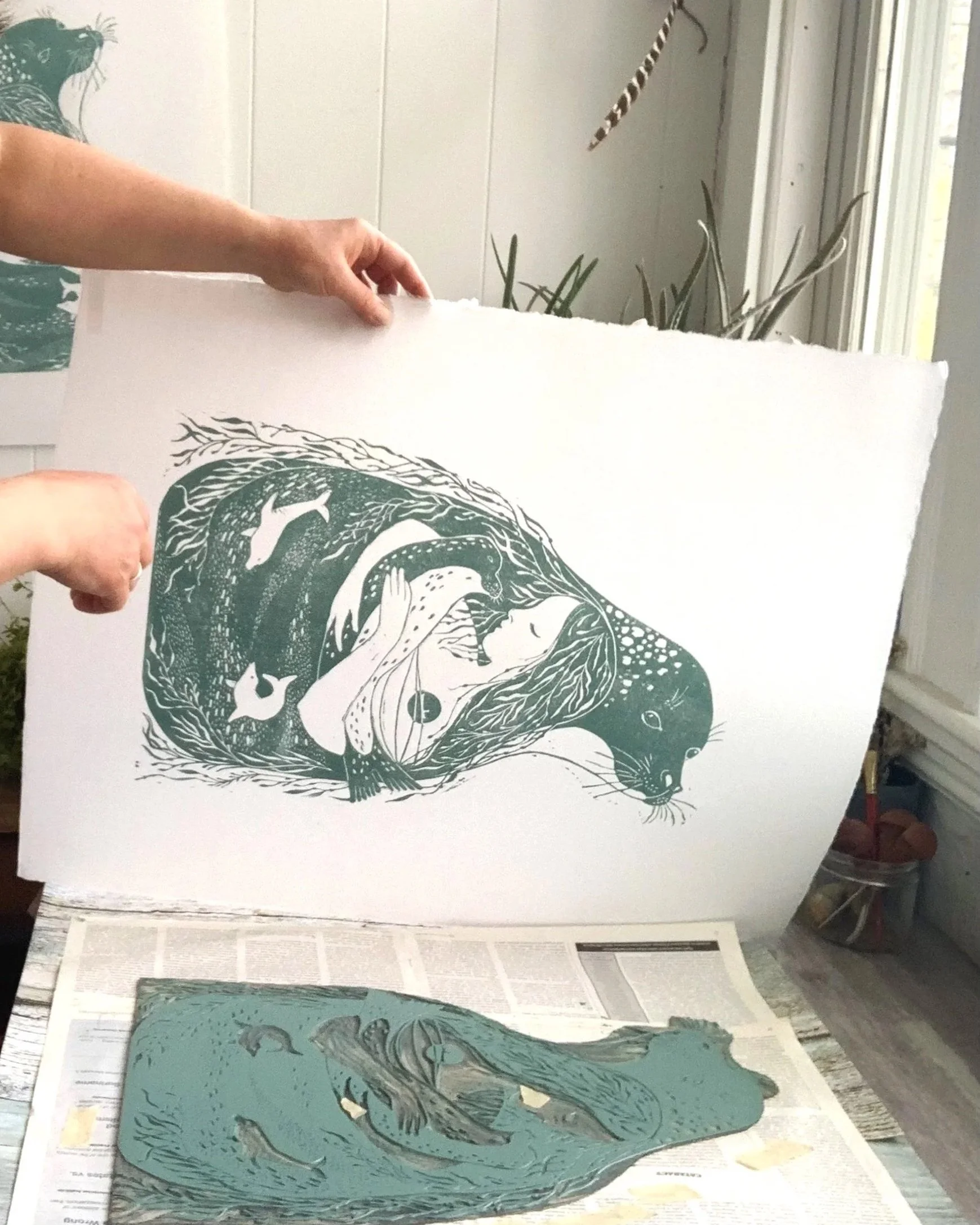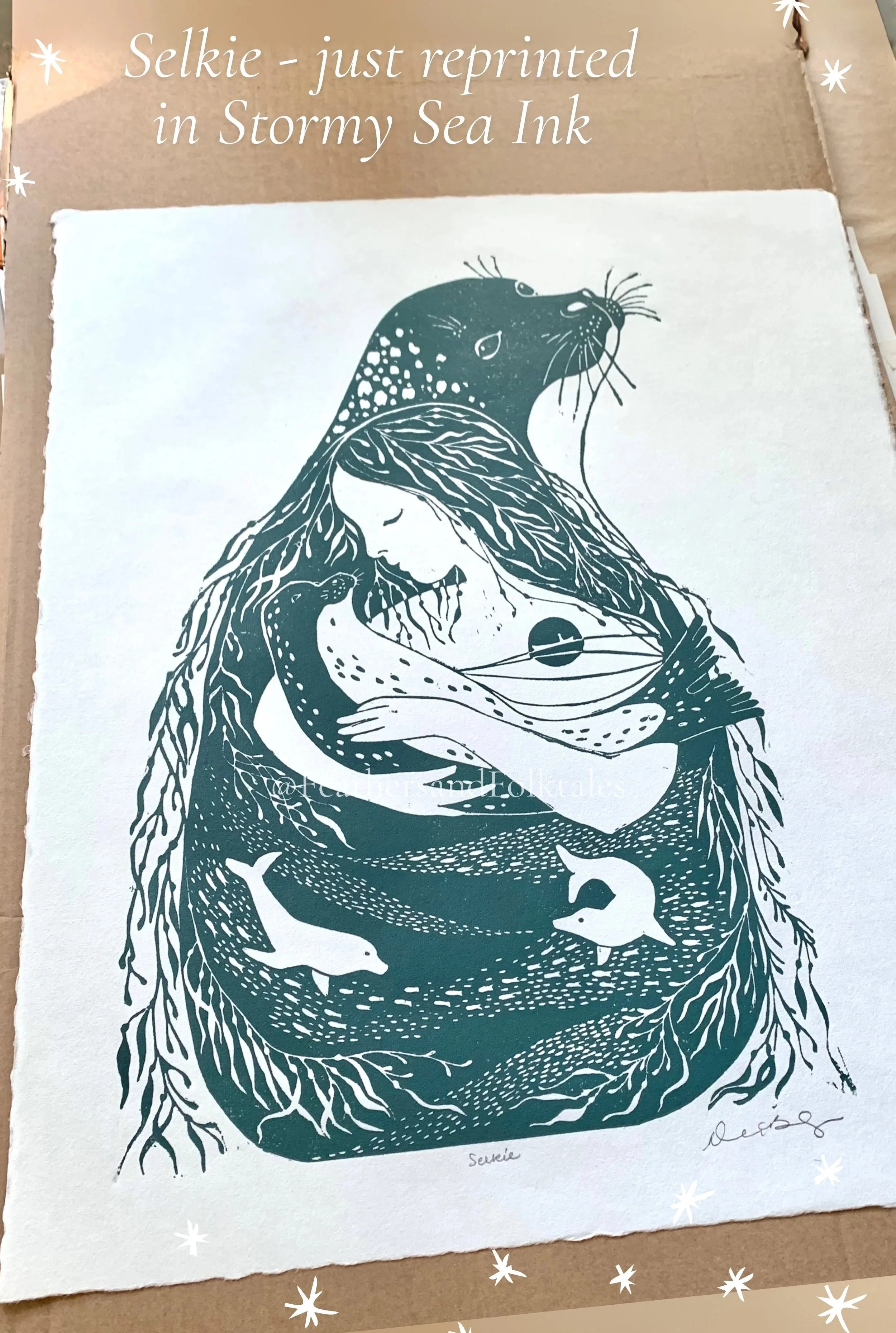Handcarving a block of artist’s linoleum.
The block of artist’s linoleum half way through carving a design inspired by the folklore of the Selkie.
Linocutting is also known as lino printing, or linoleum art is a modern form of printmaking which historically began in China, and has since had a long global journey. It is similar to traditional woodblock printing where a piece of linoleum is carved into a design and a layer of ink is rolled on top and then pressed onto paper to make an imprint. Like woodblock printing, it carries the marks of the maker—cuts, lines, and the texture of hand-rolled ink. These small imperfections give each print a rustic, old-souled and storied charm. It’s a craft that pairs naturally with folklore, folktale, fairytale themes and motifs, preserving old-time tradition and wisdom using modern materials.
In the photos provided on this page, and videos below, you can see the different stages of creating a linocut print. First, a design is sketched out on a piece of artist’s linoleum. A great deal of thought goes into the organizing the shapes and textures, lights and darks, and figuring out which parts of the linoleum block need to be carved and which parts get left untouched in order to achieve the desired image. Once the design process is complete, next comes the carving that is done with small gouge tools. When the linoleum is rolled with thick ink, and paper is hand pressed on the top, the carved-out portion creates a negative area that is left white. The final prints are bold and powerful, with high contrast between paper and ink.
The photos on this page show the process of carving and printing my Selkie-inspired linocut design. To me, there’s more to linocutting than what first meets the eye—it carries a quiet kind of poetry. The rhythm of the carving, the wave-like sound of the brayer rolling ink—it all echoes the pulse of the sea that lives inside the Selkie tale. This is where craft and story begin to intertwine.
Unlike digital or machine-made prints, linocuts embrace imperfection. Every hand-carved line, every irregular patch of ink, holds the mark of the maker. In this way, linocut holds something akin to the Japanese idea of kintsugi—a philosophy that honors what is imperfect, impermanent, and incomplete. These values also live in wabi sabi, a worldview that finds beauty in the worn and weathered, the handmade and humble.
The Selkie story, too, is shaped by these same sensibilities. She is not a polished heroine. She is wild, elusive, and full of contradiction. Though she reclaims her stolen sealskin and returns to the sea, she leaves behind her child. The story doesn’t tie itself up neatly—but that’s what makes it resonate so deeply. It leaves us with grief, memory, and the ache of something unresolved. Like the prints themselves, the story bears the marks of what is real, and in doing so, touches something true in us.
In a two-layer reduction linocut (as demonstrated in the videos below), the process is divided into two parts where the linoleum block is carved and printed with a light color ink, and then the block of linoleum is carved a second time and printed with a darker ink. In a reduction linocut, you can only make a limited number of prints because once you carve the linoleum block a second time, you can never return to the first layer.
Pulling a print off of an inked block of carved artist’s linoleum
Traditional handcarved printmaking is an art form that has long been created by artisans and is associated with ordinary people rather than upper classes. This is because printmaking allows for duplication of an image which makes it accessible to a wider audience. Traditional printmaking also relies on the simple materials of wood or linoleum, a carving tool, natural inks, and paper rather than expensive materials. I love how the medium of linocut printmaking not only pairs so well with folktales and folklore which originate from ordinary folk, but because of its duplication capacity, it also becomes more accessible to ordinary people than traditional oil painting.
Since linoleum is softer than wood and has no grain, linocuts can show a wider variety of effects than woodcuts. It is possible to etch out fine feathers, strands of fir and scales on a fish as well as details such as the bark of a tree or blades of wild grasses enabling these distinctive textures from nature to come to focus. Folktale art often has symbolic meanings, the clear contrasts and bold colors that are unique to block printing allow for these symbols to come to focus. Many folktales also have a simple, deep message, as well as contrasting themes like good and evil, or love and hate, and linocuts, with their clearly defined shapes, patterns and textures really allow for these themes to be effectively expressed. In the case of my Selkie design, this method captures something essential about the legend itself. The raw marks of the blade echo the salt-air roughness of the shore where the Selkie lives. The high-contrast imagery, half human and half seal, mirrors the dual nature she bears.
Both printmaking and storytelling are vessels of folk wisdom, one is crafted by hand the other spoken by mouth - yet both carry the weight of timeless tradition, and rustic charm. FeathersandFolktales offers a window into a world where the work of handwork and the rhythm of story entwine, root us deeper and bring old wisdom to life. There is lore in the labor, meaning in the making and cross-culture of the carving and the craft. I hope what I offer stirs something in you - a remembering, a returning, a quiet kind of magic.
Video series: a two-color reduction linocut
2. After the block is carved, a layer of ink is rolled onto the linoleum
3. Paper is pressed on top of the ink and an image is imprinted on the paper. Here is the first layer in what is called a “two-layer color reduction linocut”
4. In a two-layer color reduction linocut, the same block of linoleum is carved once more
After carving the linoleum block a second time, here I am rolling another layer of ink onto the block before printing a second time.
The final print of a two-layer color reduction linocut










In these shadowed and fractured times, when visions of one world rise against one another, we must remember the Sacred Seamstress who eternally weaves worlds back into belonging. She appears as Na'ashjé'ii Asdzáá, Spider Grandmother of the Navajo, or as Amaterasu Omikami, the Japanese Shinto sun goddess, or the Valkyries of Norse legend just to name a few . . .This feminine archetype dwells in the shadows wearing a thousand forms and names. Perhaps she awaits within you? Now is the time to call her forth, and she will rise; nourish her, and she will flourish. Explore a few of her many faces and wisdoms in this blog.